#its interesting that it used taisetsu na hito...
Explore tagged Tumblr posts
Text
Persona 3 Portable 100 Mysteries pages 28-29.
望月綾時のマフラーの素材は何?
自分の身長以上はあろうかという、非常に長い黃色のマフラーがトレードマークとなっている望月綾時。では、このマフラーの素材は何なのだろうか。
綾時のマフラーは非常に薄手であり、垂らしている様や風にたなびく様を見るに、材質的には非常になめらかで柔らかいもの反使用している=とがわかる。このことから、素材は、カシミヤなどの上質なものであることが推察できる。
ここで、綾時と同じくマフラーを身に付けている女主人公の冬服を見てみよう。その名は「アンゴラニット」。つまり、女主人公の服 (及びこフラー) の素材はアンゴラなのだ。「アンゴラ」 とは上質な毛糸で、柔らかくなめらかな素材であり、綾時のマフラーの素材を考察するうえでも候補に挙げられるものである。
同時に、綾時のキャラクター性を考えてみよう。綾時は10年前から主人公の中にいた “死神い” のシャドウ 「デス」 である。その10年で綾時 (デス) と主人公の間には、強いつながりが出来たのだ。そのつながりの強さは綾時として出現した当初、記憶を失っていたにもかかわらず、本能的に主人公を 「大切な人」 と認識したことからもうかがえるだろう。そして、その気持ちは身につける衣服にも現れたのである。綾時が人として生成された時に、最も身近に親しんだ素材を参考に形成したのではないだろうか。また、人として生成された綾時本人がマフラーを選んだのならば、強いつながりを持つ女主人公と同じような物を本能的に選んだと考えるのが自然なのである。
つまり、綾時のマフラーの素材は、女主人公の身に付けている物と同じ 「アンゴラ」 であると結論づけられるのだ。
結論 アンゴラ
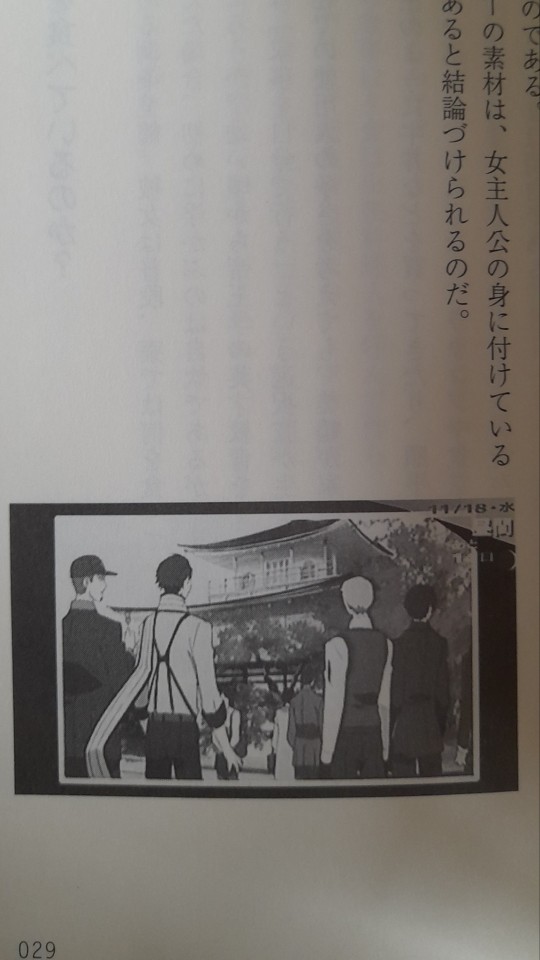
#persona 3#p3#i did one of ryojis first my bias is obvious as ever#its interesting that it used taisetsu na hito...#what ryoji calls heroine is daiji na hito(my dearest) and afaik he never actually says that?#well he does in reload(someone very special) but this is from 2010
5 notes
·
View notes
Text
The Things That Matter
I’ve talked a lot over the last two months or so about the many different ways that the characters, story, and themes of the Kingdom Hearts series align with the framework of the Heroine’s Journey. For the final chapter in this series of essays, I’d like to talk about what it means for this series to follow this narrative formula. Because the fact that Kingdom Hearts fits into this storytelling pattern is critically important now more than ever.
The three most recent series I know of that aligned with the Heroine’s Journey framework all ended up missing the landing in various ways. Two of the three - Voltron: Legendary Defender and the Star Wars sequel trilogy - abandoned the formula in their final installments, while the third one - the Frozen movies - managed to fit into the formula almost completely, but suffered in the second movie from a lack of clarity as to which of the two leads is the main protagonist and which is the Animus. Two of these were under the Disney umbrella, and all three have had evidence found that executive meddling or other behind-the-scenes conflicts over story direction played a role in how the final installments ended.
As I mentioned in my essay “Into the Unknown,” when a story deviates from the structure it appears to be following, it produces a visceral sense of wrongness in the audience. In stories which up toward the end aligned with the Heroine’s Journey, that effect is amplified. The framework of the Heroine’s Journey was designed to uplift the experiences of identities outside of what society considers the default option in storytelling. The lived experiences of those identities are mirrored in the narrative’s themes. So when a story set up around calling out prejudices and double standards about those identities that are ingrained into the audience’s culture deviates from that formula, the result inevitably ends up reinforcing those biases instead, on top of the brokenness of the narrative in general.
In terms of how this applies to Kingdom Hearts, Sora and Riku’s individual character arcs have been noted by many LGBTQ+ fans to have notable parallels with elements of their own lived experiences:
Riku’s arc of learning to accept his darkness as something natural that’s a part of him and which he can express in a positive way mirrors how many LGBTQ+ people grow up with the idea that same-sex attraction is “sinful” and “unnatural” and have to unlearn that mindset in order to realize that there’s nothing wrong with them. Likewise, Mickey’s line in Re:COM about how spending time with Riku has positively changed his opinion about Darkness can be read as an analogy for straight people who are initially unsure of or hostile to LGBTQ+ identities changing their minds with education and first-hand interaction to become staunch allies. Esmeralda’s talk with Riku about how “There are just some things we need to keep separate from the world at large, at least until we have time to figure them out”[1], while on one level is referencing Riku’s Darkness and his inner turmoil relating to Ansem, can also describe the common LGBTQ+ experience of being in the closet and hiding that part of yourself from the people around you[2].
As for Sora, in Kingdom Hearts III he responds to Davy Jones’ comments in The Caribbean about the romantic relationship between Will and Elizabeth by saying that “I still have a lot to learn about love[3],” indicating he lacks understanding of his own feelings in the area of romance. This is supported by the official Kingdom Hearts Character Files book published by Square in February 2020. Short stories in this book featuring Sora’s POV depict him as actively confused about what romantic love is[4], and struggling to define the nature of his relationship with Riku[5][6]. This can be a common experience for LGBTQ+ youth growing up surrounded by media that only ever depicts romantic relationships as one boy, one girl. Many people who grew up like this—myself included—have had similar experiences of struggling to understand our own feelings about someone of the same gender because for our entire lives up to that point we had little or no exposure to the idea that being romantically interested in someone of the same gender as you was an option.
Sora and Riku are each written in ways that speak to common LGBTQ+ experiences, and the fact that so many things—the canon parallels to Disney romances, the match with how love interests are portrayed in the Heroine’s Journey, the fact that one of the series’ Lead Event Planners Michio Matsuura was described by the Co-Director Tai Yasue to be “head over heels for the bond between Riku and Sora’s hearts[7]”, in connection with his enjoyment of “pure love dramas[7]”—are all pointing to the conclusion that these similarities did not happen by accident, but by design.
It makes so much sense for Heroine’s Journey narratives to be used to tell LGBTQ+ stories because there are so many ways that homophobia and transphobia overlap with and are rooted in the very same gender and cultural norms that the framework challenges. Many countries have come a long way towards public acceptance of LGBTQ+ identities, but in terms of the stories that we tell, mainstream fiction is still skewed in favor of stories with protagonists who are straight and cisgender. Storylines with straight romance are treated as a society-wide default, while creators in countries like the U.S. who want to include even the smallest background references to LGBTQ+ relationships have had to fight and push back against corporate pressure to remove them.
This is especially true for media aimed at children and teenagers, as the fact that being openly LGBTQ+ is still widely considered problematic in many countries is frequently used by entertainment executives in ostensibly more progressive countries as an excuse for censoring LGBTQ+ storylines and characters. Multiple creators working on animated shows for Disney and/or its competitors have spoken out in recent weeks about the resistance they faced to including LGBTQ+ relationships[8][9][10] and how they were told that openly acknowledging characters as non-straight was too controversial or “inappropriate for the channel"[9].
As a consequence of this environment, creators wishing to depict non-heterosexual relationships have had to resort to creative methods of getting the implications past the censors in a way that LGBTQ+ audiences would recognize while still maintaining plausible deniability so that the executives could make money off the story in anti-LGBTQ+ markets. The downside to this is that because these efforts are more subtle, most straight audiences will either not notice the implications, or else dismiss them as an accident. Some will go as far as coming up with alternate explanations to justify why any potential LGBTQ+ subtext about a character or relationship could not possibly have been put there by the creator intentionally.
This extends not only to audiences, but also to people who interact with these stories in a professional capacity, such as translating and marketing a story’s international release. Animated shows that feature same-gender relationships have had international dubs change the gender of one character in the pairing to make it straight, for instance. Or there's the infamous example of how the English dub for Sailor Moon in the 1990s changed two girls from lovers to cousins in order to provide an explanation for their closeness that didn't involve acknowledging that the characters were not straight. In terms of the Kingdom Hearts series, the English localization has routinely downplayed LGBTQ+ subtext in the series while in some cases adding romantic undertones to interactions between a male and female character that did not exist in the original Japanese script. Kingdom Hearts III was one of the most egregious examples of this:
Hercules’ recollection of how he dove into the River Styx to save Megara’s soul in KH2 is thematically connected to Riku sacrificing himself for Sora at the Keyblade Graveyard through the phrase taisetsu na hito (literal meaning: “precious person”) when Hercules is talking to Sora in Olympus and when Mickey is talking to Riku in the Realm of Darkness at the beginning of the game. The English version translates this as “person I love most” for Hercules, while changing it to “what matters” for Riku and Mickey to call back to his meeting with Terra in Birth by Sleep, which the scene includes a flashback to. While Mickey and Riku’s original meaning can still be deduced from the conversation around it, especially with Mickey saying "sometimes you care about someone so much," changing the line for the sake of a callback downplays the evolution of Riku’s goals from protecting “things that matter” to protecting “the *person* who matters”.
Donald and Goofy’s teasing Sora in the scene at Galaxy Toys where Sora comments on how much he or Riku resemble Yozora is framed in the English version as “Riku would be a great action figure because he’s cool, unlike Sora.” However the original Japanese indicates that the teasing is centered around the fact that Sora said a character who looks like Riku was good-looking.
When Kairi offers Sora a paopu fruit, she says in the original Japanese that it’s simply a good luck charm so that they don’t get separated, while in the English localization, she says “I want to be a part of your life no matter what, that’s all.” While “that’s all” still fits with how the parallels to Winnie the Pooh indicate her connection with Sora has weakened and she wants to maintain it, the first part of the English line calls back to the legend of the fruit introduced in KH1, which was openly referred to as romantic by Selphie in the original and localized versions of the first game. As a result, this adds romantic implications that contrast with Sora’s unreceptive body language and facial expressions[11] as he reacts to the initial offering of the paopu fruit.
In the original Japanese, Riku’s words to Sora before his sacrifice at the Keyblade Graveyard translate to “I believe in you. You won’t give up.” The English localization changed it to “You don’t believe that. I know you don’t.” Not only does it remove a callback to the original game, but this phrasing dowplays Riku’s faith in Sora and ignores Sora’s very clear feelings of inadequacy.
During the scene where Sora and Kairi are floating through the dark tunnel toward the Keyblade Graveyard, Sora’s line in English, “I feel strong with you,” was originally an acknowledgement of Kairi’s strength that called back to how he wouldn’t let her come along on the return trip to Hollow Bastion in the first game because he thought she’d “kind of be in [his] way”[12]. Removing this callback takes the focus away from Kairi’s growth and brushes aside one of the ways the game shows that Sora’s view of her has changed over the course of the series.
Some fans defend changes such as these insisting that the development team had to have approved of them. However Testuya Nomura himself feels strongly enough about the subject: he stated in a 2018 interview several months before KH3's release that “an incorrect or defective translation risks compromising the comprehension of the whole story,” referring especially to the Kingdom Hearts series[13], and the English localization of Re:Mind—which was much more accurately translated than the base game—directly references the original meaning of Kairi’s words during the paopu scene in one of the DLC’s Kingstagram posts. This all indicates that changes such as these that remove important connections or change the meaning of the conversation are ones that the development team very much do not approve of.
LGBTQ+ fans of Kingdom Hearts who recognize their own experiences reflected in Sora's and Riku’s journeys know that Disney has not had a good track record when it comes to depicting LGBTQ+ characters in properties they are affiliated with. The most we ever get in their movies are background moments or nameless characters that are only there in one scene that easily can be cut out for distribution in countries with heavy anti-LGBTQ+ legislation. And that’s if the character’s orientation is even mentioned out loud in the film at all instead of simply being confirmed by interviews before or after release but never acknowledged on-screen. Television has fared better, but until recent years we never had any main characters who were confirmed in-show to be anything but straight. But things are slowly starting to improve. Within the last few years shows like "Andi Mack" and "The Owl House" have depicted major characters as openly interested in others of the same gender[14], and Pixar recently released a short as part of their Sparknotes program called “Out”, which openly centers on a man worrying about telling his parents he’s gay.
This is why it is so important that the Heroine’s Journey of Kingdom Hearts follow through to a structurally appropriate conclusion, with the development team being given the freedom to tell their story in full without restriction or censorship. Deviating from the formula this late in the series would represent a continuation of the recent trend of Heroine’s Journey narratives being structurally broken by inference from forces other than the main creative team. But if the Kingdom Hearts story is able to complete it’s Heroine’s Journey without executives or localization teams getting in the way of the intended story, then the LGBTQ+ themes already present in Sora and Riku’s journey will break so many barriers,challenge people’s expectations of what is possible, and convey powerful messages of self-discovery and acceptance—just like the framework was designed to.
Sources
[1] Kingdom Hearts 3D: Dream Drop Distance; Square Enix; 2012.
[2] Tumblr post by @blowingoffsteam2; December 3, 2019. https://blowingoffsteam2.tumblr.com/post/189461796759/blowingoffsteam2-dont-mind-me-over-here-just
[3] Kingdom Hearts III; Square Enix; 2019.
[4] Translation of KH Character Files Beast’s Castle story by @lilyginnyblackv2; February 3, 2020. https://lilyginnyblackv2.tumblr.com/post/611420864489062401/character-files-beasts-castle-story-english
[5] Translation of KH Character Files Arendelle story by @lilyginnyblackv2; March 3, 2020. https://lilyginnyblackv2.tumblr.com/post/611490139845345280/character-files-arendelle-story-english
[6] Translation of KH Character Files Arendelle story by @notaseednotyet; March 1, 2020. https://twitter.com/notaseednotyet/status/1233993459670765569
[7] “Message from the KINGDOM” Updates!; April 11, 2012. https://www.khinsider.com/news/-Message-from-the-KINGDOM-Updates-2427
[8] “”Steven Universe” and “She-Ra” creators on Representation”; Paper Magazine; August 5, 2020. https://www.papermag.com/rebecca-sugar-noelle-stevenson-2646446747.html
[9] Twitter thread by Gravity Falls creator Alex Hirsch; August 9, 2020. https://twitter.com/_AlexHirsch/status/1292328558921003009
[10] Twitter thread by Owl House creator Dana Terrace; August 9, 2020. https://twitter.com/DanaTerrace/status/1292321440029478917
[11] Frame by frame analysis of Sora and Kairi’s body language during the KH3 paopu scene by @notaseednotyet; September 14, 2019. https://twitter.com/notaseednotyet/status/1172774158167506944
[12] Kingdom Hearts; Square Enix; 2002.
[13] “Nomura stresses the importance of direct translations on story comprehension, and talks about world development as well as the Gummi Ship;” August 27, 2018. https://www.kh13.com/news/nomura-stresses-the-importance-of-direct-translations-on-story-comprehension-and-talks-about-world-development-as-well-as-the-gummi-ship/ [14] Disney’s The Owl House Now Has a Confirmed Bisexual Character; August 9, 2020. https://io9.gizmodo.com/disneys-animated-series-the-owl-house-now-has-a-confirm-1844665583
49 notes
·
View notes
Text
Ultimania Updates-SRT
Gathered in one place, here’s the updates from the new Ultimania (and maybe some other tidbits) added to the Sleeping Realm Theory (SRT) doc so far. The sections these updates are found in are bolded so you can find them within the doc and read the surrounding context:
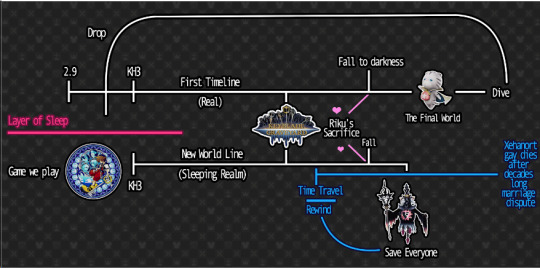
1. The Theory Itself
Time travel at KG to save everyone’s hearts has been confirmed by Nomura! Look, see, where we said the second timeline went Save Everyone > Time Travel / Rewind > Xehanort Gay Dies After Decades Long Marriage Dispute, that’s been confirmed!
Q: When we leave the Final World, we are back to the point just before Sora and his friends were defeated. Why is that?
Nomura: “The power of awakening is essentially "the power to put sleeping hearts back the way they were." But the impact of forcing his friends' fading hearts back the way they were rewrote reality, and created a singularity. The rewrite caused the chronology in which they were destroyed to have "never happened." Source
2. Dive to the Heart
Now that the main interview with Nomura has been translated, it’s confirmed a very important thing for this theory.
“Q: The Final World, a place very important to the story, appeared in the game, but what kind of world is it?
A: It is a place where those just a step from death arrive, connected to the Station of Waking. Up until now, the Station of Waking was always a dark place where the floor was made of stained glass, where the condition of the inside of one's heart could be shown, but in this case I made The Final World a place where I could show [that] more concretely, a place similar to a portal to [people's] respective hearts. Within the game, it's said that sleep and death are intimately linked, so if one's heart were in a state of sleep and they found themselves in the Station of Waking, the idea is that if they moved on from there, they would find themselves in The Final World.” - Nomura, KH3 Ultimania.
What this says basically, is to arrive in The Final World during Dive to the Heart in the first place, your heart should already be “in a state of sleep”. Nomura has confirmed, before the first DTTH we see, at the very start of the game we play, Sora is already in a state of sleep.
3. KHII.9(Context: This update is placed in the translation section talking about Riku’s growth from saying his wish is to have “strength protect the things that matter”- “Daiji na mono”- in BBS to “strength to protect my cherished person” in KH3- “Taisetsu na hito”)
The Ultimania actually goes out of its way to explicitly state this growth on Riku’s character page: “‘I want to become strong enough to protect the things that matter.’ Roughly 10 years later, after many twists and turns, he has finally obtained the strength to protect the person who matters.”
4. KH3 for realsies this time
(Context: This one is in regards to the “logo conspiracy”, just to show that this sort of obscure hinting is not beyond something Nomura would do)
In an interview with Nomura in 2016, he revealed that he hid secret clues in the cover art for 1.5, 2.5, and 2.8. Because of course he did, I guess!
“Nomura: There are actually two secrets about the illustrations from [KH1.5] until [KH2.8]. Extremely attentive KH fans might have already discovered them, but one is that Sora's movements change from sitting, to standing, to walking. One more is that when you line up the three illustrations, you'll notice that they show the flow of time with changes in the sky. [KH1.5] is sunset becoming night, [KH2.5] is the middle of the night, and [KH2.8] is night breaking into dawn. Those three illustrations have a message regarding the final chapter, [KHIII].”
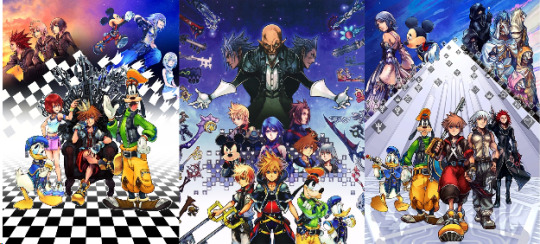
Ultimania Update: Oh boy did you think Nomura was done? Cause he wasn’t!

These party people were confirmed by Nomura in the Ultimania to actually be robed figures, sneakily placed to look apart of the building, people hidden in plain sight. What’s silly is that people had been wondering this exact thing when the box art had been revealed, and that too got shot down on the same premise of “reading too much into it”.
5. The Paopu Fruit
In the Ultimania, Irino (Sora’s VA) stated that they recorded two versions of the paopu scene:
Irino: “We recorded both a sharing scenario and a not sharing scenario. During the editing, it wasn’t decided which [Nomura] would go with, but it seems in the end he went with the sharing scenario.” - KH3 Ultimania VA Interview
In an unseen timeline (the waking/real world) a litany of things could go differently, and while this tidbit could be nothing, it’s at least an interesting note and a fun little fact.
6. Flowmotion and Attraction Flow
There’s a section showing concept art and planning for Attraction Flows. (thanks to @gummiphoned for the discovery and photos!)
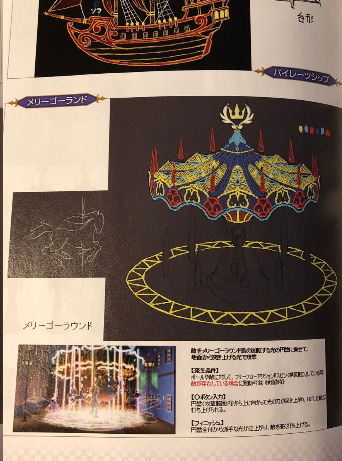
In the bottom corner, there’s an in game concept example.
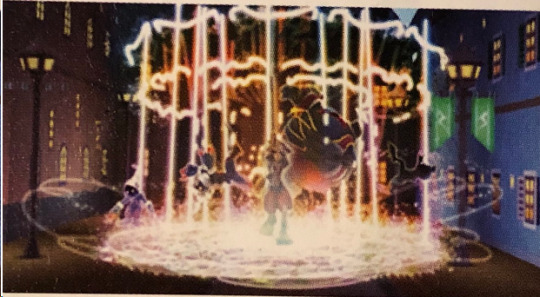
With Sora in his DDD outfit.
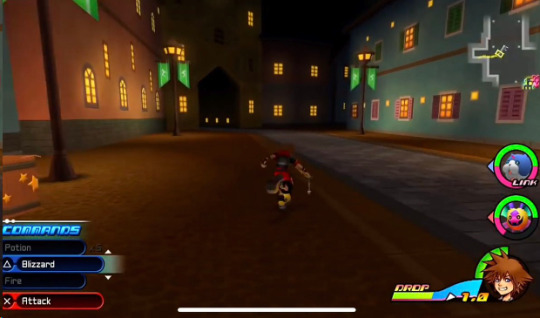
Set in DDD’s Traverse Town.
7. Reality Shift
There’s a section that elaborates a little on the Combined Keyblade, confirming it to be the very same one we see in DDD.
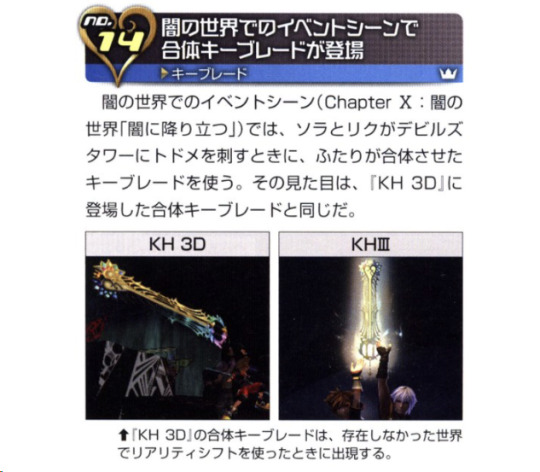
Top Text: "During the special event in the realm of darkness, when Sora and Riku deal the finishing blow against the Demon Tower, the two of them used their fusion keyblade. That keyblade is the same as the one that appeared in 3D."
Bottom Text: "In 3D this fusion keyblade appeared in The World That Never Was when using Reality Shift."
8. Promotional Materials
Later, official sources started to use a simple but unrelated, specific hashtag.
夢しかない (yume shika nai) translated to “ONLY DREAM” or just “There is only a dream”. The first time it’s used was the 6 days to go countdown
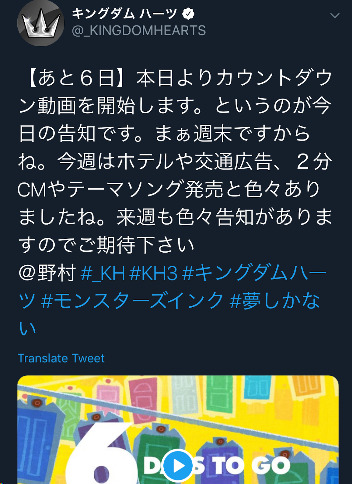
It was then used moving forward in all promotional tweets including release day (PlayStation japan was also using the tag). The last time they used this was the secret movie announcement tweet.
9. The Secret Ending
This has actually been confirmed by Nomura to take place after KH3 and that when Sora disappears in the ending he arrives here. More or less exactly as we thought.
“Q: I see. Then, continuing on, I'd like to ask about the secret movie; is the location connected to the ending? A: Yes. After disappearing in the ending, Sora arrives in the world shown in the secret movie.” - Nomura, KH3 Ultimania.
10. Shibuya, Baby!
Nomura also made note that this Shibuya isn’t the original in universe TWEWY world Shibuya. It’s Shibuya, but ~Shibuya~. As in, some kind of alternate version.
“Q: Is the place Sora is in the same world as the one in The World Ends With You?
A: It looks that way. However, rather than saying Sora has gone to the TWEWY world, the meaning is that it's not exactly Shibuya, but ~Shibuya~ (note: this is hard to explain in English, but instead of it being written in kanji, the name for "Shibuya" is written in katakana here. This basically means it's not the same Shibuya as in TWEWY or in the real world.) Also, although Sora promised Neku and his friends that they would meet again in Shibuya, this video is not connected to that.” - Nomura, KH3 Ultimania
11. Rage Form
From the Dengeki Playstation interview:
--There's a form that appears called "Rage Form," which reminds us of the "Anti Form" from KH2. What is the setup behind that?
Nomura: The forms in this title are very different from that of KH2, so we decided to change all the names. Rage does indeed have characteristics that are reminiscent of Anti, but it's basically a separate thing setup wise. Anti is based on Sora getting completely stained in darkness, but Rage doesn't go quite that far. It's based on him going into a rampage state, controlled by feelings of anger.
12. Namine
Nomura has since elaborated a little bit on what happens with Namine tho it still doesn’t really answer the biggest question. It’s said that when Kairi took the blow from Xehanort, this set her free (even if we don’t see a heart whatsoever). Nomura plans on explaining it more down the road, apparently.
13. Xion
Nomura has since stated in an interview that upcoming DLC will go into Xion and how she’s here so, hooray!
163 notes
·
View notes
Text
Dark Enchantress
Following on from last week’s essay, I would like to talk about one character who has often been overlooked both in-universe and out. Someone who was a major character in the first game, but whose presence has diminished in the years since, even as subsequent games have subtly laid the groundwork for her return to prominence.
I’m talking of course, about Maleficent.
Because of the fact that she hasn’t been a major threat since the first game, many fans tend to overlook Maleficent in later Kingdom Hearts games and dismiss her as an unimportant distraction, or even an outright joke. Outside of Re:coded, her schemes have had no immediate impact on the overarching plot of any games, and she’s constantly overshadowed by bigger antagonists like Xehanort.
However within the framework of the Heroine’s Journey, Maleficent fills a crucial role that has not yet been completed. To explain, I must first elaborate a bit more on the narrative archetype into which Sora and Rikus’ relationship falls:
The character dynamic between the protagonist and their Animus in a Heroine’s Journey often follows what I have heard others informally label as a Dark Youth/Light Youth narrative[1]. There is no official name for this archetype, so I will be referring to it by the terms it was labeled as when I first learned of it. While the archetype is not exclusively used for romances, many Heroine’s Journey romances fit into this dynamic, as romantic Dark Youth/Light Youth stories tend to follow Beauty and the Beast, rivals-to-lovers, and enemies-to-lovers archetypes.
The Light Youth is most commonly the protagonist of a story, while the Dark Youth typically serves as a Shadow figure to the main character. While there have been rare instances where a Dark Youth is the protagonist of their own story, in most examples, the Dark Youth will be a deuteragonist to the Light Youth. The Dark Youth represents what their counterpart could have become had their circumstances been worse, and in a coming of age narrative they symbolize the more turbulent aspects of growing up.
They typically begin the story as an anti-villain or tragic villain before transitioning to an anti hero or outright hero by the end, with their interactions with their light youth counterpart gradually driving them to change for the better. For all that various groups in fandom spaces will debate about whether or not a character “deserves” redemption, a well-written Dark Youth archetype is meant to teach younger audiences that no matter how many mistakes you make, it’s never too late to turn things around and do better.
Some examples of Light Youth/Dark Youth pairs include:
Belle & the Beast (Beauty & the Beast)
Aang & Zuko (Avatar: The Last Airbender)
Rey & Kylo Ren (Star Wars: Episodes VII - IX)
Lucy & Edmund Pevensie (The Chronicles of Narnia: The Lion, The Witch, and The Wardrobe)
Allura & Lotor (Voltron: Legendary Defender)
Kagome & Inuyasha (Inuyasha)
In many examples of this dynamic, the Dark Youth often spends a significant portion of the narrative under the spell of an Evil Sorcerer figure. Someone whose actions and influence create or maintain a rift between the Dark Youth and their counterpart. In order for the story to reach its climax, the Evil Sorcerer’s control over the Dark Youth must be overcome. This hold can be literal in the sense that they are physically holding the Dark Youth captive, or it can be metaphorical in the sense that their words and actions influence the Dark Youth psychologically.
While the character that fills this role in the narrative isn’t required to be magical at all, one of the most common forms this archetype takes is the Wicked Witch (hence why I refer to it as the Evil Sorcerer). In Dark Youth/Light Youth stories that deal with themes that are relevant to real world experiences, they can often take the form of an abusive parental figure, like Fire Lord Ozai in Avatar or High Priestess Haggar in Voltron.
Thus, we come to Maleficent. Despite the fact that she hasn’t been a serious threat since the first game, her influence still lingers. She spent much of her screen time in the original game convincing Riku that Sora had abandoned him, driving him down the path to villainy. Despite working in every game since to redeem himself, her influence still casts a shadow over his interactions with Sora. While they reconciled during their reunion in Kingdom Hearts II, Sora and Riku did not meaningfully address the latter’s behavior during the first game.
Sora’s views about “Riku” in Chain of Memories prior to the Replica reveal indicate that he believes Riku was not in control of his actions and was therefore blameless for what happened. But we as the audience know that despite being manipulated by Maleficent, Riku was in control of his actions. In order for the rift between the two to fully heal, they need to have a conversation where they talk about why Riku behaved the way he did and, in doing so, they must get to the heart of why Riku was so jealous of Sora.
As mentioned in my previous essay, the depiction of Riku and his bond with Sora across the series is consistent with how love interests in the Heroine’s Journey are portrayed. In addition to this narrative pattern, multiple textual parallels with canon Disney couples point towards Riku and Sora having romantic feelings for each other:
In the first Kingdom Hearts, we have two prominent moments of one character calling out for another as the party flees the location of the world’s boss while it quakes around them: Aladdin calling out for Jasmine as the party flees the Cave of Wonders, and Sora calling out for Riku as the party flees Monstro’s stomach.
Kingdom Hearts II uses plot details involving Disney Princess romances to foreshadow Sora and Riku’s reunion in The World That Never Was.
Aladdin is avoiding Jasmine at the start of the first visit to Agrabah just like how Riku is avoiding Sora throughout the game as a whole.
After being freed from Xaldin’s influence in the first visit to Beast’s Castle, the Beast is afraid to talk to Belle after how he behaved, just like how Riku didn’t want Sora to find him after how he acted in the first game. (Notably, we don’t get to see the Beast’s curse broken until *after* we’ve seen Riku no longer trapped in Ansem’s form)
Ariel is afraid that since she’s a mermaid and Eric is a human that he’ll reject her, just like how Riku didn’t want Sora to see that he’d taken on Ansem’s form.
When Sora, Donald, and Goofy are separated from Rapunzel and Flynn in the Kingdom of Corona during Kingdom Hearts III, Goofy says that Rapunzel and Eugene will be fine as long as they’re together. The last time this phrasing was used in the series, Goofy was saying that about Sora and Riku.
Kingdom Hearts III connects Riku’s sacrifice for Sora in the Keyblade Graveyard with Hercules diving into the River Styx to save Megara’s soul. (This is more clear in the original Japanese, as the localization translated the term taisetsu na hito [literal meaning: precious person] as “person I love most” for Hercules and “what matters” for Riku.)
In Jungian psychology, which the Heroine’s Journey is heavily influenced by, the Evil Sorcerer working to keep the romantic leads apart is symbolic of romantic/sexual interference. They represent cultural forces attempting to dictate what kind of romantic relationship is socially acceptable for people who share some aspect of the protagonist or Dark Youth’s identity.
Maleficent got her hooks into Riku at the beginning of the series by convincing him that Sora didn’t value him or their bond. Since then, he’s gone to the opposite extreme. Instead of lashing out over his jealousy of not being the center of Sora’s attention, he bottles his feelings up. While some fans perceived his distance from Sora in recent games as him stepping back, it ‘s more accurate to say that he has resigned himself to the belief his feelings for Sora will forever be unrequited. This is best demonstrated in the Limit Cut DLC, where even after a year of multiple characters attempting to trace their connection to Sora with no results, the idea that his own bond with Sora could be important never crossed his mind until the Fairy Godmother said there was a clue in his dreams. And until Riku learns to let down his walls and admit to Sora how he feels, Maleficent will still have a hold over him.
Despite the narrative setup for a romance between the two of them, they will not be able to get together until Riku has fully broken free of Maleficent’s influence. This is the reason why the “Healing the Wounded Masculine” stage of Murdock’s formula where the protagonist and the Animus mend the rift between them is placed very close to the end of the sequence. Freeing the Dark Youth from the Sorcerer’s influence represents their relationship with their Light counterpart triumphing over the societal forces that the Sorcerer archetype represents. Until that has been achieved, neither lead is emotionally or psychologically ready to begin a relationship.
So while Maleficent may not have been as significant a threat as she was in the beginning, she still plays a major role within the framework of Sora’s Journey, and she will continue to have a presence in the series until that role has been completed in full.
Sources:
[1] Death of a Dark Youth, Desecration of the Animus; December 20, 2018. https://www.teampurplelion.com/death-of-a-dark-youth/
#kingdom hearts and the heroine's journey#kingdom hearts meta#kingdom hearts analysis#kh maleficent#soriku
34 notes
·
View notes